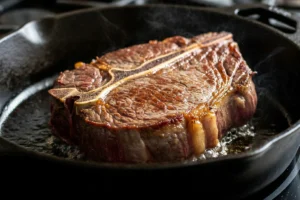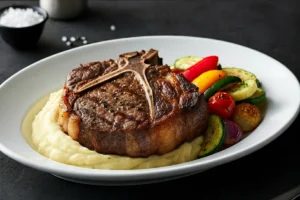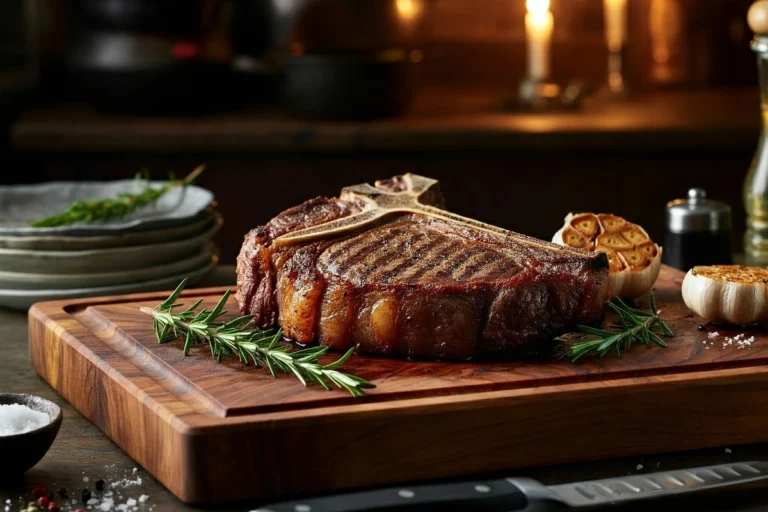Cooking a porterhouse steak can feel like an intimidating task for many home cooks. But don’t fret! This guide breaks down everything you need to know, from selecting the perfect cut to mastering various cooking techniques. Whether you prefer grilling, stovetop searing, or a combination of methods, we’ve got you covered. By the end of this article, you’ll know how to cook a porterhouse steak like a pro and impress your family and friends with a perfectly juicy, tender meal.
Understanding the Porterhouse Steak
What is a Porterhouse Steak?
The porterhouse steak is a prized cut of beef known for its exceptional tenderness and flavor. It’s essentially a two-in-one steak, featuring both the tenderloin and the strip steak divided by a T-shaped bone. This cut offers the best of both worlds—flavor-packed meat on one side and buttery softness on the other.
Porterhouse vs. T-Bone: Key Differences
While the porterhouse and T-bone look quite similar, their distinction lies in the tenderloin. A porterhouse steak has a larger portion of tenderloin compared to its T-bone counterpart. In fact, the USDA requires that the tenderloin portion be at least 1.25 inches wide for the steak to qualify as a porterhouse.
Why Choose Porterhouse?
If you’re after a hearty, flavorful steak that feeds two or more people, the porterhouse steak is an unbeatable choice. Its size and marbling ensure a juicy, mouthwatering bite every time. Plus, the bone not only adds visual appeal but also enhances the flavor during cooking.
Mastering the Art of Cooking Porterhouse Steak
Preparing Your Porterhouse Steak
Selecting the Right Cut
When learning how to cook porterhouse steak, starting with the perfect cut is crucial. Choose a steak with ample marbling for added flavor and tenderness. Look for a bright red color with a fresh smell, and make sure the tenderloin side is at least 1.25 inches wide to meet USDA standards for a true porterhouse.
Essential Tools and Ingredients
Cooking a porterhouse steak to perfection requires the right tools. A heavy-duty cast iron skillet is ideal for searing, while a grill adds a smoky flavor. Keep a pair of tongs handy for flipping without piercing the meat. Your ingredient list should include coarse salt, freshly ground pepper, high-heat oil, and optional fresh herbs like rosemary and thyme.
Marinades and Seasoning Options
While a porterhouse boasts natural flavor, seasoning enhances it further. A simple mix of salt and pepper often suffices, but you can elevate your steak with a garlic-herb marinade or a classic dry rub. Ensure the steak is at room temperature before seasoning to promote even cooking.
Cooking Techniques for Porterhouse Steak
Stovetop Searing: Step-by-Step Guide
For a crispy crust, sear your porterhouse steak in a smoking-hot cast iron skillet. Heat a tablespoon of high-heat oil until shimmering, then add the steak. Sear each side for 2-3 minutes without moving it to develop a golden-brown crust.
Oven Finishing for Perfect Results
After searing, transfer your skillet to a preheated oven at 400°F. Cook the steak for an additional 5-7 minutes for medium-rare, checking the internal temperature (135°F) with a meat thermometer. Rest it for 5-10 minutes before slicing.
Grilling for a Smoky Flavor
To grill, preheat your grill to high heat. Place the steak over direct heat for 4 minutes per side to achieve beautiful grill marks. Then, move it to indirect heat and continue cooking until it reaches the desired doneness.
Sous Vide Method for Precision Cooking
Sous vide ensures perfect doneness every time. Seal your steak in a vacuum bag and cook it in a water bath at 130°F for 2 hours. Finish with a quick sear in a hot skillet for a crispy exterior.

Know more about what makes a porterhouse steak unique at GoldyRecipe’s Porterhouse Guide.
Mastering the Art of Cooking Porterhouse Steak
Perfect Timing and Temperature
How to Achieve the Ideal Doneness
Getting the timing right is critical when learning how to cook porterhouse steak. The doneness of your steak depends on its internal temperature. Use a meat thermometer for accuracy:
- Rare: 120°F
- Medium-rare: 130°F
- Medium: 140°F
- Medium-well: 150°F
When cooking, sear each side for 2-3 minutes, then finish in the oven or on the grill, depending on your method. Always check the temperature a few minutes before the estimated cook time ends.
Using a Meat Thermometer
To avoid overcooking, a meat thermometer is your best friend. Insert it into the thickest part of the steak without touching the bone. If the reading isn’t ideal, give it another minute or two and check again. Accurate temperature readings ensure a steak that’s juicy and flavorful.
Resting the Steak: Why and How
Once you’ve cooked your porterhouse steak to perfection, don’t skip the resting period. Resting allows the juices to redistribute, keeping the meat tender. Cover the steak loosely with foil and let it sit for 5-10 minutes before slicing. This small step makes a big difference!
For more tips on perfecting steak timing, explore GoldyRecipe’s Guide to Porterhouse Cooking.
Common Mistakes to Avoid
Overcooking the Steak
One of the most common pitfalls when learning how to cook porterhouse steak is overcooking. High heat and timing are key. Avoid leaving your steak unattended during cooking, as this can result in a tough, dry texture.
Skipping the Resting Period
Cutting into a steak too soon after cooking is a rookie mistake. This causes the juices to spill out, leaving the meat dry. Always allow your porterhouse steak to rest before serving for the best results.
Using the Wrong Pan or Grill Setup
A quality pan, preferably cast iron, ensures an even sear and a golden crust. Similarly, grilling requires even heat distribution. Avoid using cookware or grill setups that don’t retain consistent heat, as they can impact the steak’s texture and flavor.
For additional cooking techniques, consider checking out related recipes on GoldyRecipe. Discover tips to elevate your culinary skills and create unforgettable dishes.
Mastering the Art of Cooking Porterhouse Steak
Sides and Pairings
Classic Side Dishes for Porterhouse
When mastering how to cook porterhouse steak, pairing it with the right side dishes elevates the entire meal. Classic options like creamy mashed potatoes, roasted asparagus, or a fresh Caesar salad complement the rich, beefy flavors of the steak. Garlic butter mushrooms and caramelized onions add a savory touch that enhances the steak’s natural taste.

Wine and Beverage Pairing Tips
Choosing the right wine or beverage can make your meal unforgettable. A bold red wine, such as Cabernet Sauvignon or Malbec, pairs beautifully with the deep flavors of a porterhouse. If you prefer something lighter, a Pinot Noir or a crisp lager works well too. Non-alcoholic options like sparkling water with a splash of lemon are refreshing and cleanse the palate between bites.
Creative Sauce Recipes to Enhance Flavor
Sometimes, a well-made sauce can add that extra zing to your steak dinner. Whip up a classic béarnaise sauce or a red wine reduction for a touch of elegance. For a bold twist, try chimichurri or a peppercorn cream sauce. These additions can transform a simple steak dinner into a gourmet experience.
Tips for Cooking Thin and Thick Cuts
Special Considerations for Thin Steaks
Thin porterhouse steaks cook quickly, so timing is everything. For a perfect sear, use high heat and cook for 60-90 seconds per side. Keep a close eye on the temperature to avoid overcooking. Rest the steak for a few minutes before serving to lock in the juices.
Cooking Extra-Thick Porterhouse Steaks
Thicker cuts require a bit more finesse. Start by searing the steak on high heat to develop a crust, then finish cooking in the oven or on indirect grill heat. Use a meat thermometer to check the internal temperature regularly, ensuring it’s cooked to your preferred doneness.
Adjusting Techniques for Consistent Results
Whether your steak is thick or thin, the key is consistency. Ensure your skillet or grill is evenly heated before placing the steak on it. Flip the steak only once during cooking to achieve an even sear and avoid losing heat from the pan or grill.
Mastering the Art of Cooking Porterhouse Steak
How to Cook Porterhouse Steak for Two
Tailoring Portions for Small Groups
Cooking a porterhouse steak for two is a delightful way to share a gourmet meal. This sizable cut of beef is naturally designed for sharing, with the tenderloin and strip sides offering a variety of textures and flavors. Choose a steak weighing around 1-1.5 pounds for the perfect portion size. Trim any excess fat to reduce flare-ups if grilling and ensure even cooking.
Romantic Dinner Presentation Ideas
Presentation plays a key role in creating a memorable dining experience. After perfectly cooking your porterhouse steak, slice the meat off the bone and arrange it attractively on a wooden board or a large serving plate. Add garnishes like fresh rosemary sprigs, roasted garlic, or a drizzle of herb-infused olive oil for an elegant touch. Pair the steak with simple sides like roasted vegetables or a fresh salad to keep the focus on the star of the meal.
Cooking for two also allows you to experiment with personalized seasoning blends or dipping sauces to suit your tastes. Mastering how to cook porterhouse steak not only impresses your partner but also showcases your culinary skills in an intimate setting.
FAQs About Cooking Porterhouse Steak
How Long Should You Cook a Porterhouse?
The cooking time for a porterhouse steak depends on its thickness and your preferred doneness. For a 1.5-inch thick steak, searing for 2-3 minutes per side and finishing in the oven for 5-7 minutes achieves medium-rare perfection. Always use a meat thermometer to check for an internal temperature of 130°F for medium-rare.
What Temperature is Best for Medium-Rare?
If you’re aiming for medium-rare, the internal temperature of the steak should be between 130°F and 135°F. Achieving this requires precise timing and temperature control during cooking. Using a thermometer ensures you don’t overcook your steak.
Can You Cook Porterhouse Without a Grill?
Absolutely! You can master how to cook porterhouse steak using a cast iron skillet on the stovetop. Sear each side to develop a golden crust, then finish in a preheated oven to reach your desired doneness. This method delivers results comparable to grilling and is perfect for indoor cooking.
Conclusion: Mastering the Porterhouse Steak Experience
Cooking a porterhouse steak is a rewarding experience that combines technique, timing, and a touch of creativity. From selecting the perfect cut to mastering the art of searing and finishing, this guide has walked you through every step of the process. Whether you’re cooking for two, experimenting with sides and sauces, or tackling thick or thin cuts, the key is understanding the nuances that make this steak so special.
By now, you’ve learned the essentials of how to cook porterhouse steak to perfection. With the right tools, careful preparation, and attention to detail, you can create a meal that’s not only delicious but also memorable. Pair your steak with complementary sides and beverages, and don’t forget to let it rest before serving to lock in the juices.
So, grab your skillet or fire up the grill, and put these tips into action. Cooking the perfect porterhouse steak at home has never been easier—or more satisfying. Happy cooking!

